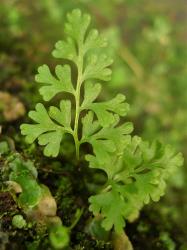- Taxon
- Gallery
- ≡ Polypodium leptophyllum L., Sp. Pl. 1092 (1753)
- ≡ Asplenium leptophyllum (L.) Sw., Obs. Bot. 403 (1791)
- ≡ Osmunda leptophylla (L.) Savigny in Desrousseaux et al., Encycl. 4, 657 (1798)
- ≡ Acrostichum leptophyllum (L.) Lam. & DC., Fl. Franc., ed. 3, 2, 565 (1805)
- ≡ Grammitis leptophylla (L.) Sw., Syn. Fil. 218 (1806)
- ≡ Gymnogramma leptophylla (L.) Desv., Mag. Neuesten Entdeck. Gesammten Naturk. Ges. Naturf. Freunde Berlin 5: 305 (1811)
- ≡ Hemionitis leptophylla (L.) Lag., Gen. Sp. Pl. [Lagasca] 33 (1816)
- ≡ Pityrogramma leptophylla (L.) Domin, Spisy Přír. Fak. Karlovy Univ. 88: 9 (1928)
- = Gymnogramma novae-zelandiae Colenso, Tasmanian J. Nat. Sci. 2: 165 (1845) – as G. novae zelandiae
Rhizomes erect, bearing pale brown multicellular hairs to 1.5 mm long. Fronds dimorphic; sterile 10–47 mm long, fertile 15–115 mm long. Stipes 8–65 mm long, red-brown, bearing a few hairs proximally. Rachises red-brown proximally, becoming green distally, glabrous. Sterile laminae irregularly flabellate to 2-pinnate, 5–29 mm long, 9–20 mm wide. Fertile laminae 1–3-pinnate, narrowly ovate to broadly ovate, 5–60 mm long, 4–42 mm wide, pale green on both surfaces, herbaceous, glabrous. Primary pinnae in 1–7 pairs below short pinnatifid apex, not overlapping; the longest at or near the base, ovate to broadly ovate, 2–30 mm long, 2–25 mm wide; apices acute to obtuse, bases short-stalked. Secondary pinnae ovate to broadly ovate, 2–15 mm long, 2–10 mm wide; apices obtuse, bases short-stalked. Ultimate segments flabellate, deeply divided; apices obtuse, bases sessile. Sori elongate along the veins, often covering the whole pinna segment at maturity; exindusiate.
Anogramma leptophylla is recognised by its small size, delicate and pale green fronds, glabrous laminae, and exindusiate sori extending along the veins and often covering the whole pinna segment at maturity.
North Island: Auckland, Volcanic Plateau, Southern North Island.
South Island: Sounds-Nelson, Canterbury, Otago.
Altitudinal range: 15–600 m.
Anogramma leptophylla occurs in lowland sites of the North Island from Auckland to Wellington, predominantly in the eastern half of the island from Hawke’s Bay to Wairarapa. It grows from around 15 m, reaching 400 m in eastern Wairarapa. In the South Island it occurs along the east coast from the Marlborough Sounds to Banks Peninsula, with an outlying population near Wanaka. It is found mostly in lowland sites but reaches 600 m at Lyndon in Canterbury.
Also Central and South America, Europe, Africa, India, China, Taiwan, Vietnam and Australia (Western Australia, South Australia, New South Wales, Victoria, Tasmania).
Anogramma leptophylla is an annual fern, sprouting in May in northern districts, later in the south, reaching maturity in August and September. It dies away as the ground dries out and regenerates each year from spores or perennial tubers on the prothalli. It is found on steep banks and rock faces, in rock crevices, on scoria bluffs, on grassy streambanks and grassy hillsides, and on shoreline rocks, often at scrub margins or under light scrub or kānuka. It grows on volcanic and calcareous substrates. It is often associated with the liverwort Targionia hypophylla and frequently grows amongst grasses and weedy species.
Anogramma leptophylla was given a conservation status of Nationally Vulnerable by de Lange et al. (2018).
n = 26 (Lovis et al. 1993).
The locality on the type sheet of Gymnogramma novae-zelandiae is given in Colenso’s writing as “Tamaki Creek, Thames”, but this is almost certainly an error for “Tamaki Creek, Auckland”. In the protologue, Colenso (1845) stated that the original collection was made “in sheltered grassy spots amongst scoria, on dry volcanic hills, between Manukau Bay and Tamaki Creek, about ten miles from Auckland”.
Anogramma leptophylla is subcosmopolitan in distribution. However, molecular analysis of populations from different geographic regions by Nakazato & Gastony (2003) indicated that distinct New and Old World clades could be recognised. Lovis et al. (1993) noted that populations from Europe, South Africa and New Zealand all had n = 26, whereas plants from Mexico had n = 27 or 29, suggesting a cytological difference between the two clades. If these cytological and molecular differences are supported by morphological differences, there would be a strong case for recognising two separate taxa. The type of A. leptophylla is from Spain and belongs to the Old World clade, which also includes New Zealand material. Any new name would therefore be applied only to the New World clade.










